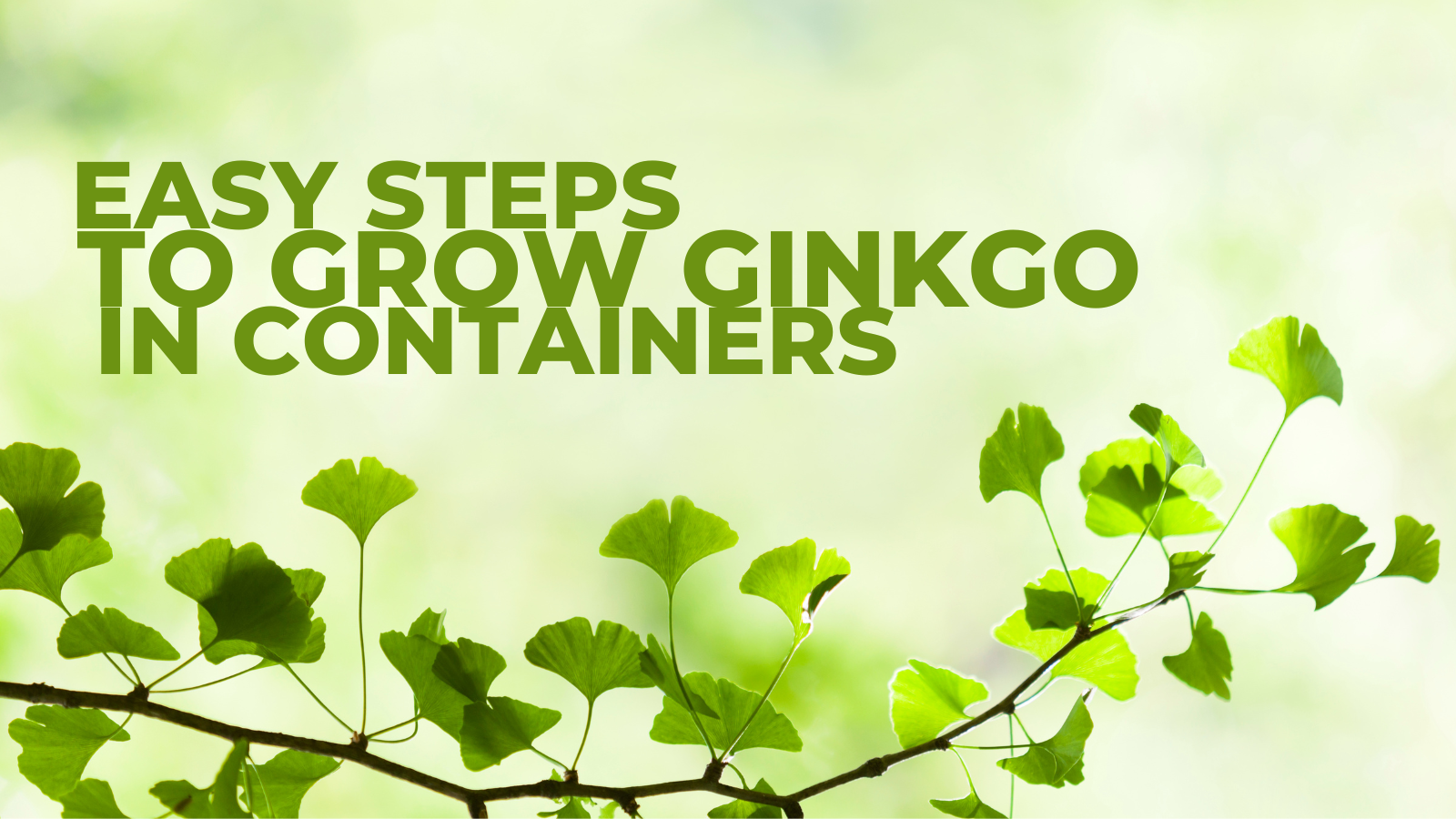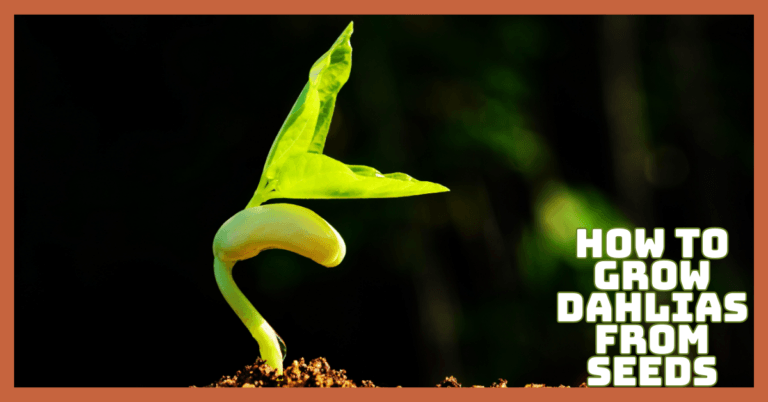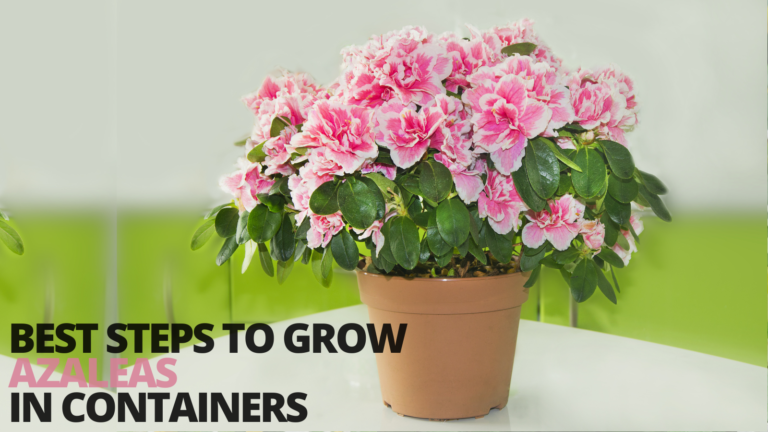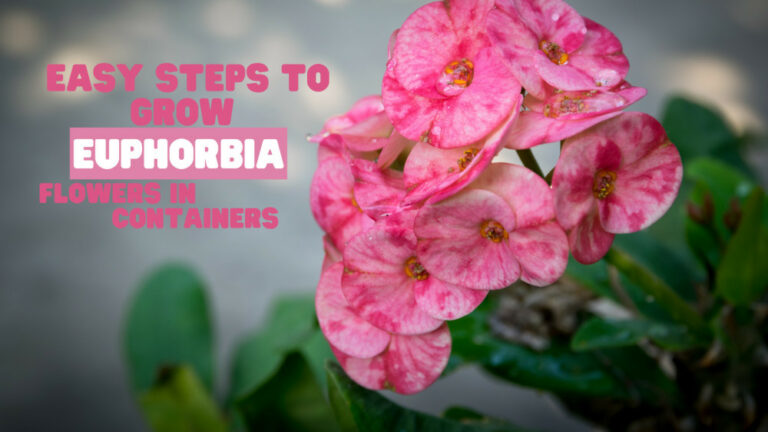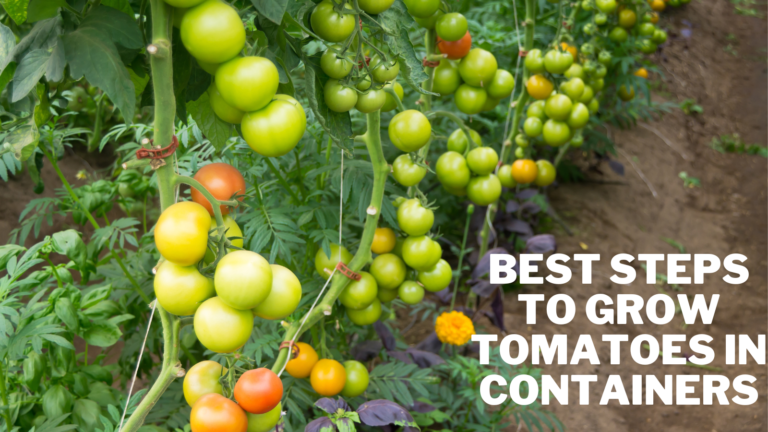Easy Steps To Grow Ginkgo In Containers
Easy Steps To Grow Ginkgo In Containers
One of the trees with the most extended lifespans worldwide is the ginkgo tree or Ginkgo Biloba. In China, where they originated, some ginkgo trees that are 2000 years old have been discovered.
Because of their height, not all ginkgo trees can be grown in pots, but many of them will look excellent on your porch or in a small garden.
Plant a smaller cultivar of the ginkgo tree in a container if you don't have the space or want to grow a giant ginkgo outside your home.

History & Origin Of Ginkgo
Ginkgo, or Ginkgo biloba, is a Chinese native gymnosperm tree of the Ginkgoaceae family, also known as the maidenhair tree.
Ginkgo is a fungus—and insect-resistant ornamental tree that has been cultivated in Chinese and Japanese temple gardens since ancient times.
It is now highly prized worldwide. Unlike most gymnosperms, it can withstand freezing temperatures and, unlike most, the unfavourable air conditions seen in urban settings.
Despite being widely farmed, the plant is threatened in the wild and is designated an endangered species by the IUCN Red List.
The only surviving member of the order Ginkgoales (division Ginkgophyta), which contains about 15 genera and dates to the Permian Period, is the ginkgo (about 298.9 million to 251.9 million years ago).
Fossilized leaves that resemble modern tree leaves can be used to identify extinct genera like Ginkgoites and Baiera.
Because it was initially uncertain whether uncultivated ginkgo groupings might be discovered in the wild, the ginkgo is frequently referred to as a living fossil.
Large ginkgo trees typically reach heights of 20 to 35 meters (66 to 115 feet), with some specimens in China reaching heights of over 50 meters (165 feet).
The tree is typically deeply rooted and resistant to wind and snow damage. It has an angular crown and long, sometimes irregular branches.
Young trees are frequently tall, slender, and sparsely branched; as the tree ages, the crown broadens.
Ginkgos are challenging, with some examples being more than 2,500 years old. This durability is attributed to disease resistance, insect-resistant wood, and the capacity to generate aerial roots and sprouts.
In traditional Chinese medicine, ginkgo has been utilized extensively. Ginkgo extract gained popularity for its alleged memory-improving qualities in several nations during the end of the 20th century. Its chemical components are being researched as a potential Alzheimer's disease treatment.
Several variants are available for usage in the landscape, including columnar forms and others favoured for their finer growth habits, select fall colours, and other desired attributes.
The female tree is less common for garden planting because of the ripened fleshy seed covering's highly unpleasant odour, comparable to rancid butter. The “nut” is roastable and a delicacy in some regions.
Different Types Of Ginkgo Trees
Ginkgo trees are exceptional in that they have survived for approximately 200 million years, primarily unaltered.
Ginkgo trees can be male or female and have lovely, fan-shaped leaves. Different varieties can grow to be large shade trees and lovely ornamental additions to gardens and landscapes. You have a variety of options to choose from.

1. Fairmont Maidenhair Tree (Ginkgo biloba)
The Fairmont Maidenhair Tree is a deciduous conifer with a thick, pyramidal crown. This tree has immature, virtually horizontal branches and mature branches that are upright.
The Fairmont Maidenhair Tree has a striking canopy of green leaves in the shape of fans that turn beautiful gold in the fall. This common shade tree thrives in full sun, mild moisture, and good drainage.

2. Princeton Sentry Maidenhair Tree
The Princeton Sentry Maidenhair Tree is a ginkgo cultivar that only has males. It has a typical upright shape with a small crown covered in leathery green leaves that turn golden yellow in the fall.
The greenery lasts for a few weeks before dropping off quickly. This tree thrives in full sun, sandy soil that is moderately moist, and soils that drain well.

3. Autumn Gold Maidenhair Tree
The Autumn Gold Maidenhair Tree is an all-male cultivar of the ginkgo tree with a wide-spreading, symmetrical crown.
It has fan-shaped leaves with long-lasting golden yellow leaves in the fall. When the leaves abruptly disappear, a lovely golden carpet surrounds the tree. To create shade, you can plant the slowly growing Autumn Gold Maidenhair Tree on your lawn.

4. Chase Manhattan Maidenhair
A dwarf ginkgo variant called the Chase Manhattan Maidenhair Tree with an upright, spreading crown.
This slow-growing, low-maintenance shrub has small, cupped, upright emerald green leaves that grow on closely spaced branches.
In the fall, the foliage turns a deep yellow-gold. This incredibly decorative tree is ideal for a rock garden. It grows well in soils with good drainage and full light.

5. Majestic Butterfly Maidenhair Tree
The Majestic Butterfly Maidenhair Tree is a deciduous ginkgo tree with an erect, vase-like crown.
This tree has fan-shaped, variegated leaves that are cream, green, and butter-yellow throughout the summer and turn gold-yellow in the fall.
This specimen tree thrives in full sun, medium moisture, and well-drained soil. You can grow the Majestic Butterfly Maidenhair Tree, a decorative pollution-resistant plant.

6. Lacy Maidenhair
The fan-shaped leaves of the Lacy Maidenhair Tree have a rough edge that gives them the appearance of lace, hence the name.
This unusual shade tree typically grows well in full sun to partial shade and in sandy, free-draining soils.
Steps To Grow Ginkgo In Containers
The maidenhair tree, often known as ginkgo Biloba, is a fascinating addition to an attractive garden.
According to fossil records, the ginkgo tree was common more than 150 million years ago, even though it nearly went extinct in recent ages.
U.S. Department of Agriculture zones 4 through 9 are suitable for growing ginkgo. Slowly but surely, the tree reaches a height of up to 100 feet. With the right location selection and upkeep, you may grow and enjoy this tree for many years.

1. Choose The Right Container
Many ginkgos grow well in pots or containers placed on a patio with other plants, and with the right care and maintenance, they can thrive there for many years.
Do not over-pot; use a pot that is no more than double the size of the one the plant purchased.
To stop soil from draining away while still allowing water to soak through, add a 1-inch layer of gravel to the bottom or lightly cover the holes in the pottery with pottery shards.
2. Site To Grow Ginkgo In Containers
Ginkgo trees thrive in metropolitan areas because they can withstand pollutants. Before planting, consider a ginkgo tree's projected maturity height and canopy width. Ginkgo trees can grow up to 100 feet tall and have a canopy between 30 and 50 feet broad.
Ginkgo trees shouldn't be planted underneath or close to power lines or other tall structures. They can endure semi-continental conditions and have a good tolerance for temperate climates. They require very slight shade or full sun. Additionally, they are wind-resistant.

3. Soil To Grow Ginkgo In Containers
The ginkgo Biloba tree may be grown in any soil. However, because the tree produces a strong taproot and needs deep soil, the soil should be well-drained but not dry up rapidly.
It grows best in bright, fertile soil. Although it loves neutral, silty, and slightly clayey soil, it may tolerate weakly calcareous soil.
If necessary, add sand to the heavy, clay-rich soil to lighten it and compost to improve the subpar substrate.
The ginkgo is tolerant of both acidic and alkaline and compacted soil and is not picky about the soil type or most soil conditions.
It prefers loam or sandy soil that drains well and has a pH between 5.0 and 8.0. Compared to many other tree species, they can tolerate compacted soil better.
4. Germinating Ginkgo Trees From Seed
If you choose to grow a ginkgo tree from seed, you can buy the seeds in various Asian markets, gardening supply stores, and online. Ginkgo seeds should germinate in moist but not soggy peat moss.
When handled dry, peat moss might release soiled dust, so prepare your germination mix outside. Place the peat moss in a Ziploc bag or seed tray to keep it at room temperature and out of direct sunlight. Seeds should be pressed about ¼ inches deep under the peat moss.
5. Sunlight Requirements Of Ginkgo Trees
Grow Ginkgo biloba in full sun to part shade. Put the pot in a location that receives both full and filtered sun. Ginkgo trees may thrive in either cool or warm environments.
To increase drainage set the pot on a plant stand or a raised surface made of brick or tiles to improve drainage.
Put the pot on the plant stand or the tiles in a tray to catch water and protect surfaces. Regularly empty the tray to keep water from collecting at the pot's base.

6. Watering Ginkgo Trees
As they establish, Ginkgo biloba trees need constant watering for the first three years of growth. Keep the soil moist because it grows slowly in dry soil, but avoid heavy, wet dirt.
If the area is well-drained, water as needed to maintain the soil's moisture. When a tree is young, moisture is crucial because it is generally drought-tolerant as it matures.
Water a new, young tree for the first several months after planting it almost every day or a few times per week.
Deeply water the roots to encourage their growth and establishment. Be careful not to oversaturate the soil. After it's established, your ginkgo tree won't require much further watering.
7. Temperature And Humidity
Ginkgo Biloba is frequently planted in urban settings throughout numerous locations, demonstrating its adaptability to various moisture levels and temperatures. In hot, dry conditions, they can, however, struggle.

8. Fertilizing Ginkgo In Containers
Although fertilizer is not typically necessary, you can boost it by applying a slow-release balanced fertilizer in the spring that contains nitrogen, phosphorous, and potassium (N-P-K), as directed on the label. It is appropriate to use a balanced 10-10-10 fertilizer.
Compost or manure should be applied annually to plants. Young Ginkgo Biloba trees can benefit from a spring feeding of tree fertilizer.
Observe the dosage recommendations on the product label. Usually, mature trees do not require feeding.
9. Propagating Ginkgo
Cuttings can be used to multiply ginkgo. Here is how to accomplish it:
- Take a 6-inch stem cutting of fresh wood from a male ginkgo tree in May or June.
- The potting mix should be poured into a 4-inch container, and the soil should be moistened. One pot can hold a couple of cuttings for at least 1 inch of space between them.
- Inject rooting hormone into the cut ends. For each cutting, poke a hole in the ground with a pencil or stick, then place the cuttings in the holes.
- Place the pot outside, away from the blazing sun, in bright, indirect light. Always keep the soil moist but not drenched.
- Once the first one has taken root, cut the other cutting to the soil line (don't pull it out, or you'll disrupt the delicate new roots).
- Report cuttings into more significant individual pots when the roots protrude through the drain holes, allowing them to grow in pots for a few seasons. The sapling's chances of surviving in the landscape are better the stronger it is when it is transplanted.
10. Mulching & Pruning Of Ginkgo Trees
The ginkgo biloba tree must be mulched to grow. To maintain moisture in the summer and shield the roots from the cold in the winter.
Many kinds of ginkgo have narrow immature leaves that become quite wide as they mature and become shade trees. You can slow down this process by pruning them when they are young to make them create a single leader.
But choosing a cultivar with a reputation for having a narrow form is a far better option. The ginkgo biloba tree is a lovely specimen that needs no more pruning unless you wish to modify its size or shape.
11. Pests & Diseases Of Ginkgo
Due to their lack of fruit, male trees are recommended (unless you have allergies). The fruit-like substance that female trees produce is a seed ball.
When it falls on sidewalks or driveways, it is not only offensive-smelling but also slick. The troublesome “fruit” is comparable in size to a cherry tomato.
Due to its high level of disease resistance, ginkgo Biloba seldom becomes sick. Mealybugs might attack it.
Spraying an equal amount of vegetable oil and liquid dish soap diluted to one teaspoon per 150 ml of water may help you eliminate them.
12. Caring For Ginkgo Trees
Rainfall may not always reach your ginkgo tree, even if your container is outside, especially when its leaf canopy has widened.
Regularly check the soil and water it if necessary. Use a slow-release fertilizer every summer to fertilize.
Save any significant pruning for the middle of the year and trim sporadically as needed the rest of the time.
Enjoy the ginkgo tree's age-old and distinctive beauty!
Benefits Of Ginkgo
1. Includes Antioxidants
Numerous health benefits of ginkgo may be due to its antioxidant content. High concentrations of terpenoids and flavonoids, renowned for their potent antioxidant effects, are found in ginkgo.
The harmful effects of free radicals are fought off or neutralized by antioxidants. Free radicals are highly reactive particles the body produces during normal metabolic processes like digestion and detoxification.
However, they also can potentially harm healthy tissues, hastening aging and disease onset. Ginkgo's antioxidant properties are promising.
However, it is still unknown how precisely it functions and how effective it might be in treating particular diseases.
2. Reduce Anxiety
According to some research, taking ginkgo supplements may help with anxiety symptoms.
Several animal studies have seen reductions in anxiety symptoms, which the antioxidant content of ginkgo may be responsible for.
In one study, 240 mg or 480 mg of ginkgo Biloba or a placebo were given to 170 patients with generalized anxiety disorder.
When compared to the placebo group, the group receiving the highest dose of ginkgo reported a 45 percent greater reduction in anxiety symptoms.
Ginkgo supplements may help people feel less anxious, but it's too soon to draw any firm conclusions from the current body of knowledge.
3. Improve Eye Health
How ginkgo affects vision and eye health has hardly been the subject of research. However, preliminary findings are encouraging.
According to one study, Ginkgo supplementation improved blood flow to the eyes in glaucoma patients, but this didn't always result in clearer vision.
Another analysis of two studies examined how ginkgo extract affected the development of age-related macular degeneration.
Some participants claimed their vision had improved, but this wasn't statistically significant for all of them.
Increased blood flow to the eye appears responsible for many of these favourable outcomes. It is unknown whether ginkgo would enhance vision in people who do not already have vision impairment.
4. Reduces PMS Symptoms
Ginkgo may help treat premenstrual syndrome's physical and psychological symptoms, according to preliminary research (PMS).
One study of 85 college students found that taking ginkgo Biloba reduced PMS symptoms by 23%.
Interestingly, the placebo group in this study also noticed a very slight improvement in PMS symptoms, albeit at a much lower rate of 8.8%.
More investigation is required to comprehend the cause-and-effect relationship between ginkgo and PMS symptoms.
5. Helps To Cure Sexual Dysfunction
According to some sources, ginkgo may be used to treat sexual dysfunction, including erectile dysfunction and low libido.
Nitric oxide levels in the blood can be raised by ginkgo, which dilates blood vessels to improve circulation.
As a result, by increasing blood flow to those areas of the body, ginkgo may also help treat a variety of symptoms of sexual dysfunction.
Ginkgo biloba has been studied for its potential to treat sexual dysfunction through antidepressant medication use (SSRIs).
According to the findings, ginkgo wasn't any more efficient in these situations than a placebo. Additionally, ginkgo and SSRI medications might interact, making them less effective.
In one study, ginkgo was used to boost sexual desire and contentment in women who were also receiving sexual psychotherapy.
Compared to a placebo, the combination of ginkgo and therapy was more effective over time, but ginkgo alone was not.
Although there is logic in using ginkgo to treat sexual dysfunction, there is currently no evidence to back this up.
Conclusion
Strong anti-inflammatory and antioxidant properties and circulation-improving properties are present in ginkgo Biloba.
Together, these traits can potentially influence many bodily functions and diseases, though the science behind them is still lagging.
Although ginkgo has been used for centuries, its exact mechanism of action is still unknown. Remembering that much of the available research is contradictory or inconclusive is crucial.
There are risks with using any herbal supplement. If you are allergic or taking certain medications, ginkgo could cause serious health problems.
Consult your doctor before adding ginkgo to your regimen if you're considering it. So don’t miss adding ginkgo to your small garden.
I trust you enjoyed this article on the Easy Steps To Grow Ginkgo In Containers. Please stay tuned for more blog posts soon. Take care!
JeannetteZ
>>>Please click here to read my all-inclusive article about Container Gardening<<<
>>>Are you interested in homegrown herbs and medicine? Please click here to find out more about it!<<<
Your Opinion Is Important To Me
Do you have thoughts, ideas, or questions? I would love to hear from you. Please leave me your questions, experiences, and remarks about this article on the Easy Steps To Grow Ginkgo In Containers in the comments section below. You can also email me at Jeannette@Close-To-Nature.org.
Disclosure
This post may contain affiliate links. I earn from qualifying purchases as an Amazon Associate and other affiliate programs. Please read my full affiliate disclosure.
You might also enjoy these blog posts:
15 Best Essential Oils For Natural Healing
30 Powerful Fruits And Vegetables With Healing Powers
Easy Steps To Grow Sunflowers In Containers
Easy Steps To Grow Echinacea In Containers
Easy Steps To Grow Allspice In Containers

